สวัสดีครับ ผมคือ Michael Zhang นักเดินทางผู้เชี่ยวชาญด้านประวัติศาสตร์และวัฒนธรรม ผมมีประสบการณ์ท่องเที่ยวระดับนานาชาติอย่างมาก และหลงใหลเป็นพิเศษในเส้นทางสายไหมและสถานที่ที่เกี่ยวข้องกับพุทธศาสนา วันนี้ผมจะพาทุกคนไปอ่าน คู่มือท่องเที่ยวเชิงลึกของเจดีย์ห่านป่าใหญ่ (วัดต้าซืออึ้น) ที่เมืองซีอาน ไม่ว่าคุณจะเป็นนักเดินทางที่สนใจวัฒนธรรม หรือเป็นผู้ชื่นชอบสถาปัตยกรรมโบราณ ผมมั่นใจว่าบทความนี้จะมอบข้อมูลอันมีค่าสำหรับการเดินทางซีอานของคุณ
สารบัญบทความ
- แนะนำเจดีย์ห่านป่าใหญ่
- แผนที่เจดีย์ห่านป่าใหญ่
- ทำไมถึงสร้างเจดีย์ห่านป่าใหญ่?
- ทำไมต้องมาเที่ยวเจดีย์ห่านป่าใหญ่?
- สิ่งที่ต้องทำเมื่อมาเจดีย์ห่านป่าใหญ่
- จุดถ่ายภาพที่ดีที่สุดของเจดีย์ห่านป่าใหญ่
- งานพิธีพุทธศาสนาในเจดีย์ห่านป่าใหญ่และวัดต้าซืออึ้น
- การเดินทางจากตัวเมืองซีอานไปเจดีย์ห่านป่าใหญ่
- อาหารแนะนำใกล้เจดีย์ห่านป่าใหญ่
- คำถามที่พบบ่อย
แนะนำเจดีย์ห่านป่าใหญ่
เจดีย์ห่านป่าใหญ่ หรือที่รู้จักกันอีกชื่อว่า “เจดีย์วัดต้าซืออึ้น” เริ่มสร้างขึ้นเมื่อปี ค.ศ. 652 ในสมัยถัง ภายใต้การดูแลของพระถังซำจั๋ง เพื่อเก็บรักษาพระสูตรและพระพุทธรูปที่ท่านนำกลับมาจากอินเดียผ่านเส้นทางสายไหม เดิมทีเจดีย์มีเพียง 5 ชั้น แต่หลังจากการบูรณะหลายครั้ง จึงกลายเป็นเจดีย์อิฐแบบศาลาเจ็ดชั้นที่สูงถึง 64.517 เมตร ฐานยาวด้านละ 25.5 เมตร
เจดีย์ห่านป่าใหญ่ถือเป็นเจดีย์อิฐสี่เหลี่ยมแบบศาลาที่ใหญ่ที่สุดในสมัยถัง และยังเป็นสัญลักษณ์ของการผสมผสานทางศิลปะสถาปัตยกรรมหลังพุทธศาสนาเข้าสู่จีนอีกด้วย ปัจจุบันที่นี่เป็นแหล่งท่องเที่ยวระดับ 5A ของจีน และยังถูกรวมอยู่ในรายชื่อมรดกโลก “เส้นทางสายไหม: เครือข่ายเส้นทางจากฉางอันถึงเทือกเขาเทียนซาน”
- ที่อยู่: ภายในวัดต้าซืออึ้น เขตเยี่ยนต้า เมืองซีอาน มณฑลส่านซี
- เวลาเปิดทำการ:
- 15 ตุลาคม – 28 กุมภาพันธ์: 08:00–17:40 (ปิดการเข้าชม 16:40)
- 1 มีนาคม – 14 ตุลาคม: 08:30–18:00 (ปิดการเข้าชม 17:00)
- เวลาโชว์น้ำพุดนตรี: 12:00–12:10, 16:00–16:10, 19:00–19:10, 21:00–21:10
- เวลาแนะนำในการท่องเที่ยว: 2–3 ชั่วโมง
- ฤดูกาลที่เหมาะสม: เที่ยวได้ตลอดทั้งปี
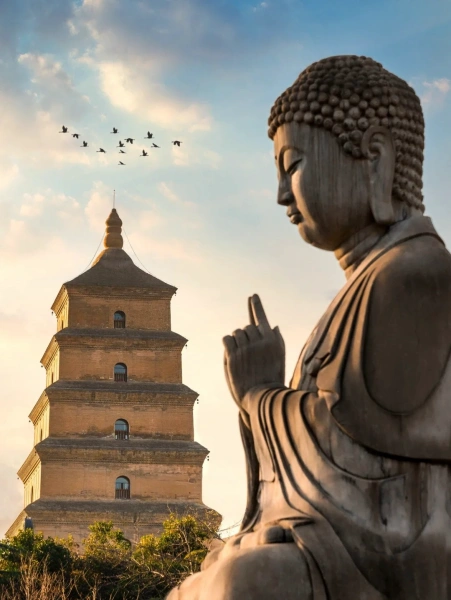
แผนที่เจดีย์ห่านป่าใหญ่

ทำไมถึงสร้างเจดีย์ห่านป่าใหญ่?
เหตุผลหลักในการสร้างเจดีย์ห่านป่าใหญ่ คือเพื่อเก็บรักษาพระสูตรและพระพุทธรูปจำนวนมหาศาลที่พระถังซำจั๋งนำกลับมาจากอินเดีย ระหว่างปี ค.ศ. 629–645 พระถังซำจั๋งได้เดินทางไปแสวงหาพระธรรมและนำกลับมาถึง 657 คัมภีร์ ท่านจึงขออนุญาตจักรพรรดิถังไท่จงให้สร้างเจดีย์ขึ้นภายในวัดต้าซืออึ้น เพื่อเก็บรักษาสมบัติล้ำค่านี้อย่างปลอดภัย
เกี่ยวกับชื่อ “เจดีย์ห่านป่าใหญ่” มีตำนานอยู่หลายแบบ แบบหนึ่งเล่าว่า ระหว่างการเดินทาง พระถังซำจั๋งเคยได้รับการช่วยเหลือจากฝูงห่านป่า พวกมันชี้ทางไปยังแหล่งน้ำ ทำให้ท่านรอดพ้นจากความยากลำบาก เพื่อเป็นการระลึกถึงเหตุการณ์นั้น เมื่อกลับถึงฉางอัน ท่านจึงสร้างเจดีย์นี้และตั้งชื่อว่า “เจดีย์ห่านป่าใหญ่”
อีกตำนานหนึ่งกล่าวว่า พระถังซำจั๋งเคยได้ยินเรื่องเล่าในอินเดียเกี่ยวกับการฝังห่านป่าและสร้างเจดีย์ ท่านจึงนำแนวคิดนี้กลับมาสร้างที่จีน และตั้งชื่อเพื่อสะท้อนจิตวิญญาณและคุณค่าทางวัฒนธรรมของพุทธศาสนา
ทำไมต้องมาเที่ยวเจดีย์ห่านป่าใหญ่?
คุณค่าทางประวัติศาสตร์
เจดีย์ห่านป่าใหญ่เป็นสถาปัตยกรรมจีนโบราณที่ทรงคุณค่า แสดงถึงความรุ่งเรืองของพระพุทธศาสนาในสมัยถัง และยังเป็นหนึ่งในเจดีย์ไม้ที่เก่าแก่ที่สุดของจีน รวมถึงเป็นเจดีย์อิฐที่เก่าแก่ที่สุดแห่งหนึ่งของโลก เจดีย์แห่งนี้สร้างขึ้นโดยพระถังซำจั๋ง เพื่อเก็บรักษาพระสูตรและพระพุทธรูปที่ท่านนำกลับจากอินเดีย
รูปแบบสถาปัตยกรรม
เจดีย์ห่านป่าใหญ่สร้างด้วยสถาปัตยกรรมแบบศาลาของสมัยถัง ตัวเจดีย์สูง 64.517 เมตร มีทั้งหมด 7 ชั้น แต่ละชั้นประดับด้วยงานแกะสลักที่วิจิตรตระการตา สะท้อนถึงภูมิปัญญาและฝีมือของช่างสมัยโบราณ นอกจากจะเป็นสถานที่ศักดิ์สิทธิ์ของพุทธศาสนิกชนแล้ว ยังเป็นที่ดึงดูดนักท่องเที่ยวด้วยความงดงามด้านสถาปัตยกรรม
คุณค่าทางวัฒนธรรม
ภายในเจดีย์บรรจุพระบรมสารีริกธาตุของพระพุทธเจ้า ทำให้ที่นี่เป็นแหล่งมรดกทางพุทธศาสนาที่สำคัญ นักท่องเที่ยวสามารถชมพระคัมภีร์และโบราณวัตถุทางพุทธศาสนาภายใน อีกทั้งยังมีสวนโบราณสถานวัดต้าซืออึ้น และป่าศิลาจารึกบทกวีถัง เพิ่มสีสันด้านวัฒนธรรมในการท่องเที่ยว
ทิวทัศน์ยามค่ำคืน
เมื่อถึงค่ำ เจดีย์ห่านป่าใหญ่จะถูกประดับไฟหลากสีสวยงาม กลายเป็นภาพที่สว่างไสวและน่าตราตรึงใจ เป็นหนึ่งในไฮไลท์ยามค่ำของเมืองซีอาน ที่นักท่องเที่ยวไม่ควรพลาดในการชมบรรยากาศอันงดงามนี้
สิ่งที่ต้องทำเมื่อมาเจดีย์ห่านป่าใหญ่
แหล่งท่องเที่ยวหลัก
เจดีย์ห่านป่าใหญ่ตั้งอยู่ภายในวัดต้าซืออึ้น โดยรอบพื้นที่วัดยังมีแหล่งท่องเที่ยวสำคัญมากมาย เช่น เจดีย์ห่านป่าใหญ่ ศาลาเฉวียนจั้งซานจั้ง และน้ำพุดนตรีจัตุรัสด้านเหนือ นอกจากนี้ บริเวณใกล้เคียงยังมี ถนนคนเดินต้าถังปู้เย่เฉิง ที่เต็มไปด้วยแสงสีและกิจกรรมยามค่ำคืน ทำให้การท่องเที่ยวเจดีย์ห่านป่าใหญ่ยิ่งน่าสนใจและครบเครื่องมากขึ้น
วัดต้าซืออึ้น
วัดต้าซืออึ้นถือเป็นหนึ่งในวัดที่สำคัญที่สุดของประวัติศาสตร์พุทธศาสนาในจีน สร้างขึ้นโดยจักรพรรดิถังเกาจง เพื่อรำลึกถึงพระราชมารดาของพระองค์ บรรยากาศภายในวัดเงียบสงบ รายล้อมด้วยสถาปัตยกรรมที่เรียบง่ายและงดงาม เหมาะแก่การพักผ่อนและซึมซับเสน่ห์แห่งกาลเวลา
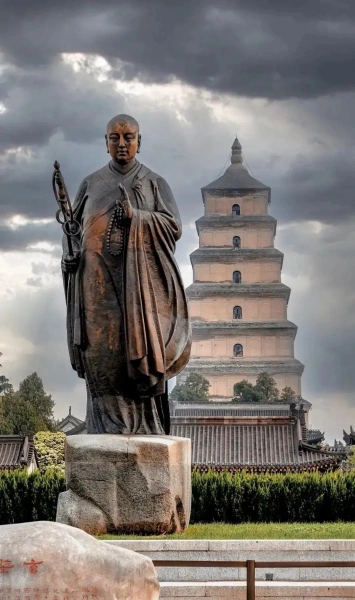
เจดีย์ห่านป่าใหญ่ (เจดีย์วัดต้าซืออึ้น เมืองซีอาน)
เจดีย์ห่านป่าใหญ่คือสัญลักษณ์สำคัญของวัดแห่งนี้ สร้างขึ้นภายใต้การควบคุมของพระถังซำจั๋ง เพื่อเก็บรักษาพระสูตรและพระพุทธรูปที่อัญเชิญมาจากอินเดีย ตัวเจดีย์สูงตระหง่านถึง 7 ชั้น โครงสร้างแบบศาลาทำให้ดูสง่างามและทรงพลัง นักท่องเที่ยวสามารถซื้อตั๋วเพิ่ม (ฤดูท่องเที่ยว 25 หยวน / ฤดูโลว์ซีซัน 20 หยวน) เพื่อขึ้นไปชมวิวจากยอดเจดีย์ ซึ่งสามารถมองเห็นวิวเมืองซีอานได้รอบทิศ ถือเป็นประสบการณ์ทางวัฒนธรรมและทัศนียภาพที่น่าจดจำ
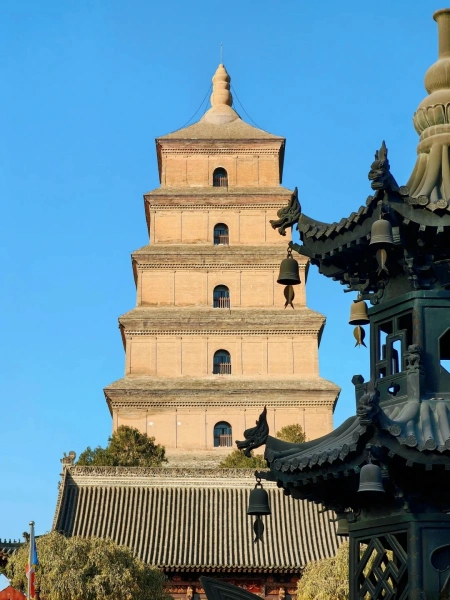
ศาลาเฉวียนจั้งซานจั้ง
ศาลาแห่งนี้ถูกสร้างขึ้นเพื่อรำลึกถึงผลงานอันยิ่งใหญ่ของพระถังซำจั๋ง ภายในจัดแสดงเส้นทางการเดินทางไปแสวงหาพระธรรมที่อินเดีย และผลงานด้านวิชาการของท่าน นิทรรศการเต็มไปด้วยบรรยากาศทางประวัติศาสตร์และข้อมูลเชิงลึก เหมาะอย่างยิ่งสำหรับผู้ที่สนใจพระถังซำจั๋งและวัฒนธรรมพุทธ
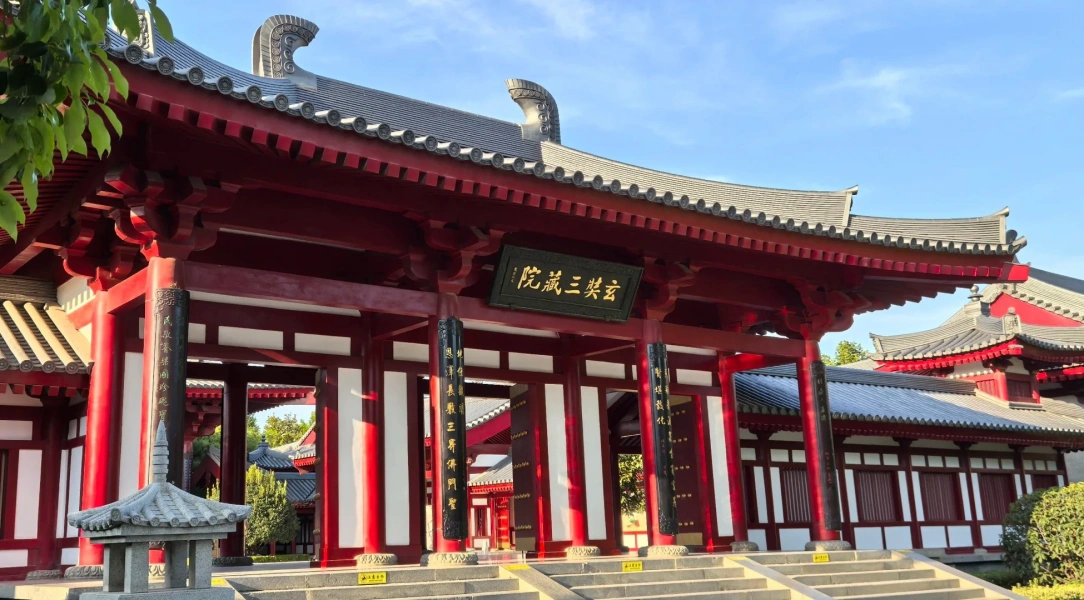
น้ำพุดนตรีจัตุรัสด้านเหนือ
น้ำพุดนตรีที่นี่ถือเป็นหนึ่งในน้ำพุขนาดใหญ่ที่สุดของโลก และยังเป็นจุดท่องเที่ยวยอดนิยมแบบไม่เสียค่าใช้จ่ายของเมืองซีอาน การแสดงผสานระหว่างแสงสีดนตรีและสายน้ำสูงตระหง่าน สร้างบรรยากาศที่น่าตื่นตาตื่นใจ เป็นสถานที่ห้ามพลาดทั้งสำหรับครอบครัวและผู้ที่รักการถ่ายภาพ
- เวลาแสดงน้ำพุดนตรี:
- 12:00—12:10 (ยกเว้นวันอังคาร)
- 16:00—16:10 (ยกเว้นวันอังคาร)
- 19:00—19:10
- 21:00—21:10
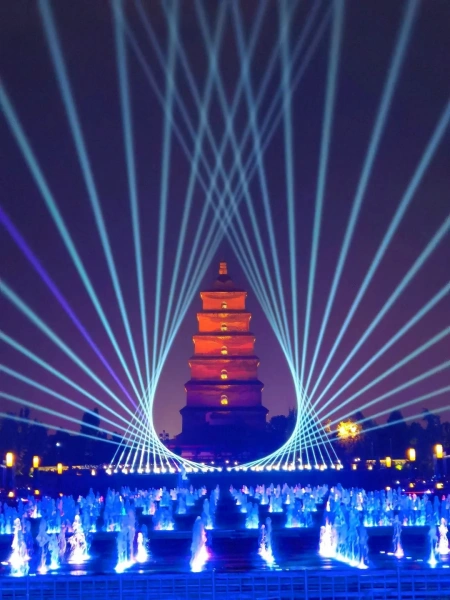
ถนนคนเดินต้าถังปู้เย่เฉิง
ถนนคนเดินแห่งนี้ตั้งอยู่ใกล้กับเจดีย์ห่านป่าใหญ่ แม้จะไม่ใช่ส่วนหนึ่งของพื้นที่วัด แต่ก็เป็นแหล่งท่องเที่ยวที่เสริมกันอย่างลงตัวกับการมาเที่ยวเจดีย์ ถนนสายนี้ตกแต่งด้วยบรรยากาศวัฒนธรรมถังสมัยโบราณ ผสมผสานกับการแสดงศิลปะร่วมสมัยยามค่ำคืน แสงไฟสว่างไสวตลอดแนวถนน ทำให้ผู้มาเยือนสัมผัสได้ถึงเสน่ห์ทั้งอดีตและปัจจุบัน อีกทั้งยังเข้าชมได้ฟรี เหมาะที่สุดสำหรับผู้ที่อยากสัมผัสบรรยากาศวัฒนธรรมจีนโบราณผสานความทันสมัย
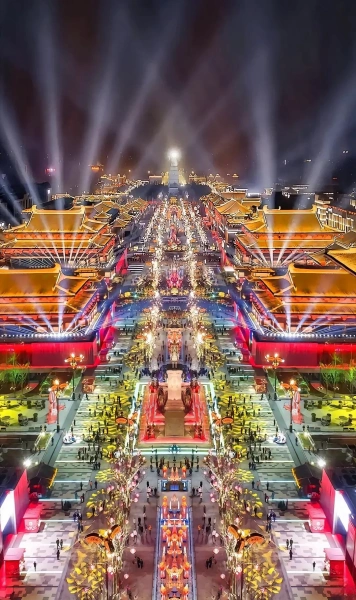
คู่มือซื้อตั๋วเข้าชมเจดีย์ห่านป่าใหญ่
ราคาบัตรเข้าชม
วัดต้าซืออึ้น
- ผู้ใหญ่: ฤดูท่องเที่ยว 40 หยวน / ฤดูโลว์ซีซัน 30 หยวน
- เด็ก/นักเรียน: ฤดูท่องเที่ยว 20 หยวน / ฤดูโลว์ซีซัน 15 หยวน (อายุ 6–18 ปี หรือนักศึกษาปริญญาตรีและต่ำกว่า)
- ฟรี: เด็กอายุต่ำกว่า 6 ปี หรือส่วนสูงต่ำกว่า 1.2 เมตร และผู้สูงอายุ 65 ปีขึ้นไป
เจดีย์ห่านป่าใหญ่ (ขึ้นเจดีย์)
- ผู้ใหญ่: ฤดูท่องเที่ยว 25 หยวน / ฤดูโลว์ซีซัน 20 หยวน
เวลาเปิดทำการ
- 15 ตุลาคม – 28 กุมภาพันธ์: 08:00–17:40 (ปิดการเข้าชม 16:40)
- 1 มีนาคม – 14 ตุลาคม: 08:30–18:00 (ปิดการเข้าชม 17:00)
ช่องทางซื้อตั๋ว
- ออนไลน์: มินิโปรแกรม WeChat
- ออฟไลน์: เคาน์เตอร์ขายบัตรที่สถานที่ท่องเที่ยว
ไกด์นำเที่ยวเจดีย์ห่านป่าใหญ่
ปัจจุบันเจดีย์ห่านป่าใหญ่ยังไม่มีไกด์อย่างเป็นทางการ แต่คุณสามารถจองไกด์มืออาชีพได้ผ่านแพลตฟอร์มท่องเที่ยวออนไลน์ ไกด์ส่วนใหญ่จะเล่าเรื่องประวัติศาสตร์ของเจดีย์ควบคู่กับการพาเที่ยวสถานที่รอบข้าง เช่น ถนนคนเดินต้าถังปู้เย่เฉิง ช่วยให้คุณได้สัมผัสทั้งความเข้มข้นของวัฒนธรรมประวัติศาสตร์ และบรรยากาศความบันเทิงยามค่ำคืนของถนนสายวัฒนธรรมในคราวเดียว ทำให้การเดินทางครั้งนี้เต็มไปด้วยสาระและความสนุกสนานอย่างสมดุล
เส้นทางท่องเที่ยวที่แนะนำในเจดีย์ห่านป่าใหญ่
- จัตุรัสด้านเหนือเจดีย์ห่านป่าใหญ่ เริ่มต้นการเดินทางจากจัตุรัสด้านเหนือเพื่อชมการแสดงน้ำพุดนตรีสุดตระการตา ที่นี่คือจุดที่ดีที่สุดในการชมวิวเจดีย์ห่านป่าใหญ่ทั้งองค์ บรรยากาศเต็มไปด้วยกลิ่นอายประวัติศาสตร์ โดยเฉพาะรูปปั้นพระถังซำจั๋งและพื้นที่กว้างขวางรอบ ๆ
- ถนนบทกวีโบราณ เดินจากจัตุรัสด้านเหนือไปทางทิศใต้ จะพบกับถนนบทกวีที่จัดแสดงองค์ประกอบวัฒนธรรมที่เกี่ยวกับกวีนิพนธ์สมัยถัง เหมาะอย่างยิ่งสำหรับผู้ที่รักงานวรรณกรรมและการถ่ายภาพ
- ประติมากรรมพระถังซำจั๋ง ตั้งอยู่ภายในวัดต้าซืออึ้น รูปปั้นนี้สร้างขึ้นเพื่อรำลึกถึงการเดินทางไปแสวงหาพระธรรมและความสำเร็จทางวิชาการของพระถังซำจั๋ง เป็นจุดยอดนิยมสำหรับการถ่ายภาพและการเรียนรู้ถึงอิทธิพลของท่านต่อวัฒนธรรมพุทธ
- ทางเข้าด้านเหนือถนนคนเดินต้าถังปู้เย่เฉิง หลังจากเที่ยวชมเจดีย์ห่านป่าใหญ่แล้ว สามารถเดินไปยังถนนคนเดินต้าถังปู้เย่เฉิง เพื่อเริ่มต้นประสบการณ์เดินเที่ยวในถนนสายวัฒนธรรมถัง ยามค่ำคืนมีการแสดงศิลปะร่วมสมัยและไฟประดับสวยงาม เหมาะสำหรับการถ่ายภาพและลิ้มลองอาหารท้องถิ่น
- จัตุรัสไคหยวน ที่ปลายด้านใต้ของถนนต้าถังปู้เย่เฉิง คือจุดสิ้นสุดของการเดินทางเชิงวัฒนธรรม เต็มไปด้วยประติมากรรมและงานศิลป์สมัยใหม่ ปิดท้ายวันอย่างสมบูรณ์แบบ
จุดถ่ายภาพที่ดีที่สุดของเจดีย์ห่านป่าใหญ่
- สวนโบราณสถานวัดต้าซืออึ้น (ประตูทิศใต้) พื้นที่ใกล้พระพุทธรูปองค์ใหญ่คือจุดถ่ายภาพยอดนิยมที่สามารถเก็บภาพเจดีย์ห่านป่าใหญ่พร้อมทิวทัศน์โดยรอบได้มุมกว้าง เหมาะสำหรับผู้ที่ชอบถ่ายด้วยเลนส์ไวด์
- หน้าประตูหลักวัดต้าซืออึ้น (บริเวณรูปปั้นพระถังซำจั๋ง) หากยืนด้านล่างขวามือของรูปปั้น จะสามารถเก็บภาพนักท่องเที่ยวพร้อมรูปปั้นและเจดีย์ในเฟรมเดียว ถือเป็นมุมถ่ายภาพคลาสสิกที่ห้ามพลาด
- ประตู 3 ของห้าง Dayuecheng กำแพงสีแดงที่นี่สร้างมุมมองที่โดดเด่นเมื่อถ่ายคู่กับเจดีย์ ไม่ว่าจะถ่ายภาพมุมกว้างหรือภาพระยะใกล้ กำแพงสีแดงจะช่วยเสริมบรรยากาศวัฒนธรรมให้โดดเด่น
- ชั้น 4 ของจุดชมวิว Dayuecheng ขึ้นลิฟต์หมายเลข 4 จากประตู 3 ไปยังชั้น 4 จะสามารถชมวิวพาโนรามาของเจดีย์ห่านป่าใหญ่จากมุมสูง เหมาะสำหรับการถ่ายภาพเชิงสร้างสรรค์
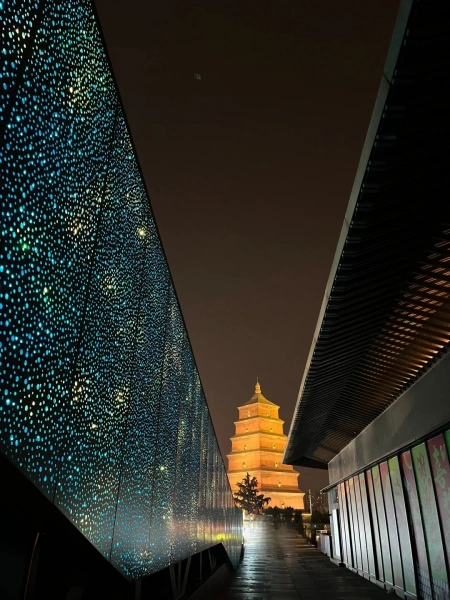
งานพิธีพุทธศาสนาในเจดีย์ห่านป่าใหญ่และวัดต้าซืออึ้น
เจดีย์ห่านป่าใหญ่และวัดต้าซืออึ้นมักจัดพิธีทางศาสนาพุทธเป็นประจำ นักท่องเที่ยวทุกคนสามารถเข้าร่วมได้ ตัวอย่างเช่น ในช่วงสอบระดับมัธยมและมหาวิทยาลัยของจีน วัดจะจัดพิธีสวดมนต์เพื่ออวยพรนักเรียน โดยสวดพระสูตร “วัชรปรัชญาปารมิตาสูตร” และ “พระสูตรพระพุทธเจ้าสมณโคดมแห่งแสงครามหินยา” เพื่อเสริมสิริมงคล
นอกจากนี้ ในวันที่ 8 เดือน 12 ตามปฏิทินจันทรคติ วัดจะมีการแจกโจ๊กละปาให้ฟรีแก่ผู้ที่มาร่วมงาน ถือเป็นสัญลักษณ์แห่งความโชคดีและพรอันเป็นสิริมงคล พิธีเหล่านี้ไม่ได้มีตารางเวลาที่แน่นอน หากนักท่องเที่ยวบังเอิญมาเจอ ก็ควรเข้าร่วมเพื่อสัมผัสประสบการณ์ทางจิตวิญญาณที่หาได้ยาก
ภายในวัดยังมีร้านจำหน่ายของที่ระลึกทางศาสนาและศูนย์ Cien Cultural Creative ซึ่งขายสินค้าพุทธศาสนาหลากหลายชนิดที่ได้รับความนิยมสูง โดยมีของแนะนำดังนี้:
- วัชรครุฑ (คทาวัชระ): สัญลักษณ์แห่งความแข็งแกร่งและความไม่รู้จบ
- ระฆังวัชระ: แทนปัญญาสูงสุดในพระพุทธศาสนา
- น้ำเต้า: แทนความโชคดีและความมั่งคั่ง
นอกจากนี้ สร้อยประคำที่ซื้อมา แนะนำให้สวมที่มือซ้าย เพราะตามคติพุทธ “ซ้ายรับ ขวาส่ง” จะช่วยดึงดูดพลังมงคลได้ดียิ่งขึ้น
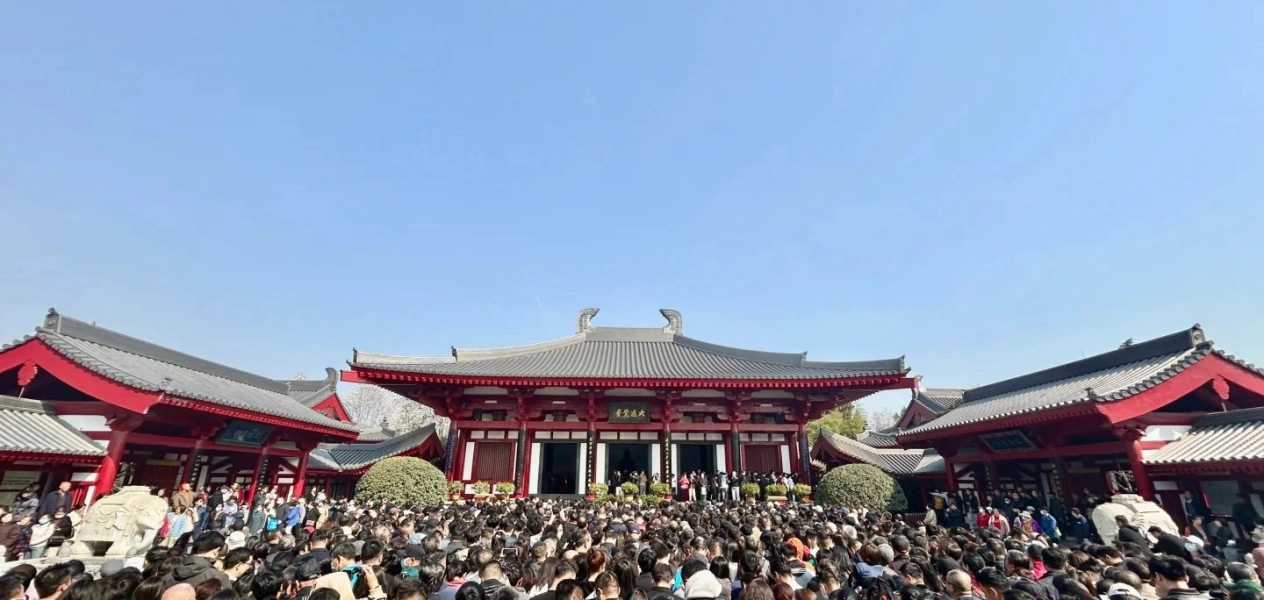
การเดินทางจากตัวเมืองซีอานไปเจดีย์ห่านป่าใหญ่
รถไฟฟ้าใต้ดิน
โดยสารรถไฟฟ้าใต้ดินสาย 3 หรือสาย 4 มาลงที่สถานี เจดีย์ห่านป่าใหญ่ จากนั้นเดินเท้าเพียงไม่กี่นาทีก็ถึงตัววัด รถไฟฟ้าใต้ดินเปิดให้บริการตั้งแต่ 06:00–23:00 สะดวกและรวดเร็ว
รถประจำทาง
มีหลายสายที่วิ่งตรงมายังเจดีย์ห่านป่าใหญ่ เช่น สาย 5, 21, 22 ลงที่ป้าย จัตุรัสด้านเหนือเจดีย์ห่านป่าใหญ่ แล้วเดินต่อเพียงไม่กี่นาที
แท็กซี่ / รถบริการออนไลน์
การเดินทางด้วยแท็กซี่หรือรถบริการออนไลน์จากตัวเมืองซีอานใช้เวลาประมาณ 20–30 นาที ค่าโดยสารอยู่ที่ 20–40 หยวน อย่างไรก็ตาม ช่วงเวลาเร่งด่วนเช้า–เย็น อาจมีการจราจรติดขัด ควรเผื่อเวลาเดินทางล่วงหน้า
อาหารแนะนำใกล้เจดีย์ห่านป่าใหญ่
ร้าน奔跑吧陝菜·雁塔長安 (สาขาถนนต้าถังปู้เย่เฉิง)
- ตำแหน่ง: ถนนต้าถังปู้เย่เฉิง
- ค่าใช้จ่ายต่อคน: ประมาณ 50 หยวน
- เหตุผลที่แนะนำ: ร้านนี้ขึ้นชื่อเรื่องอาหารส่านซีแบบต้นตำรับ ปริมาณอาหารคุ้มค่าและตั้งอยู่ทำเลดีมาก สามารถชมเจดีย์ห่านป่าใหญ่ได้จากหน้าร้าน จึงเหมาะทั้งสำหรับการลิ้มรสอาหารพื้นเมืองและซึมซับบรรยากาศทางวัฒนธรรม
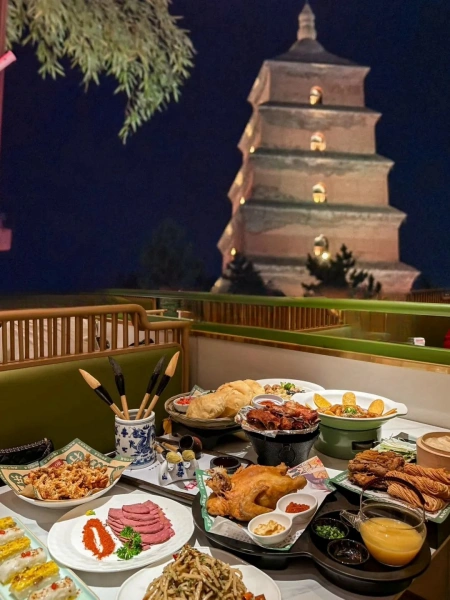
คำถามที่พบบ่อย
พื้นที่ส่วนใหญ่ของเจดีย์ห่านป่าใหญ่มีทางเดินเรียบ เหมาะสำหรับนำรถเข็นเด็กเข้าไป อย่างไรก็ตาม ภายในตัวเจดีย์ต้องปีนบันได จึงไม่สามารถนำรถเข็นเข้าไปได้ หากวางแผนจะขึ้นเจดีย์ ควรจอดรถเข็นไว้ด้านนอก หรือใช้สายสะพายอุ้มเด็กแทน จะสะดวกกว่ามาก
นักท่องเที่ยวสามารถใช้บริการฝากสัมภาระฟรีที่ศูนย์บริการนักท่องเที่ยวซีอาน
-ตำแหน่ง: เดินจากทางออก C ของสถานีรถไฟฟ้าใต้ดินเจดีย์ห่านป่าใหญ่ไปยังศูนย์บริการ
-เวลาเปิดบริการ: 09:00–22:00
หลังจากฝากสัมภาระแล้ว นักท่องเที่ยวสามารถเดินเที่ยวได้อย่างสบาย ไม่ต้องกังวลกับการถือกระเป๋า
รวมลิงก์แนะนำเที่ยวซีอานที่จำเป็น
- คู่มือเที่ยวซีอานฉบับสมบูรณ์ 📖
- แนะนำที่พักในซีอาน 🏨
- คู่มือการเดินทาง ✈️ 🚇 🚄 🚆
- เคล็ดลับและข้อมูลจำเป็นในการเที่ยวซีอาน 🗺️ 🍜 📱 💸 🌤️ 💊

 English (US)
English (US)  繁體中文
繁體中文 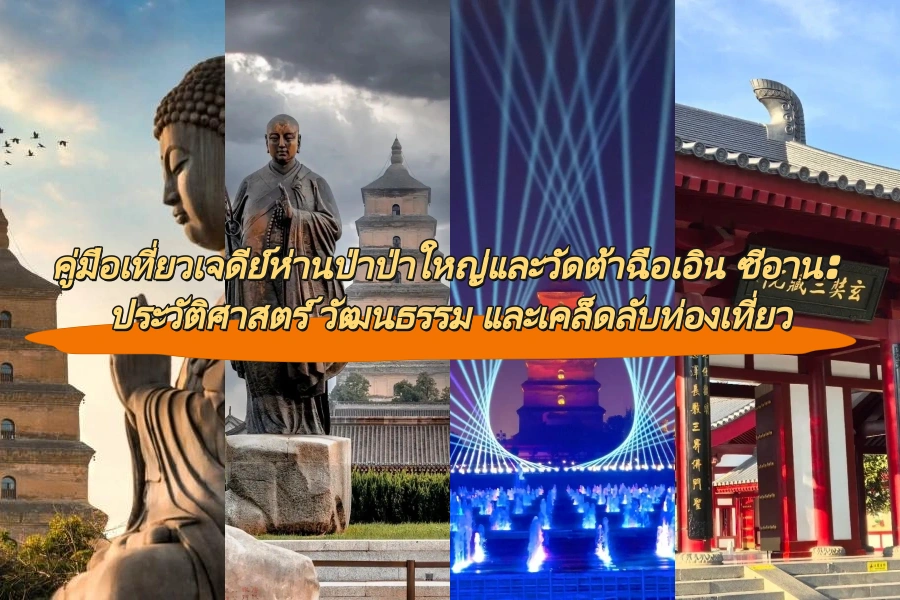
Comment (0)